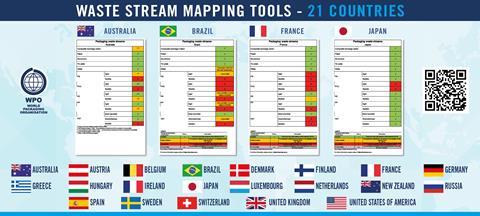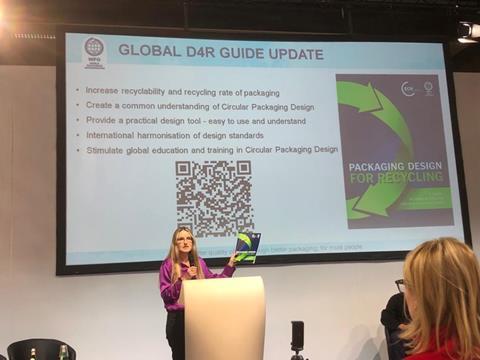
The World Packaging Organisation (WPO) has launched Waste Stream Mapping Guides for 21 countries as part of its Global Packaging Design for Recycling Guide programme.
Each Waste Stream Mapping Guide includes a simple table with entries for different materials: composite beverage cartons, paper, aluminium, tin plate, glass, and plastic. The plastic category is further divided into specific polymers, accounting for rigid and flexible PS, PVC, PE, PP, and PET.
Each Guide includes a colour-coded system for understanding the collection flows of these different packaging types. For example, when a collection flow is available, the table will include a green box with a tick to indicate there is area-wide collection with over 50% of the material retrieved.
In the case that there is limited collection flow available, this will be shown by a yellow box and wave symbol, suggesting that the material is collected in some regions or municipalities, but the total amount is around 10% to 50%. For packaging types where there is no collection stream available or the collected waste amount for the material is less than 10%, the box will be red with a cross inside.
The WPO developed the Guides in partnership with FH Campus Wein University of Applied Sciences, Austria, Circular Analytics, and ECR Community. The countries that now have dedicated guides, available on the WPO website, are Australia, Austria, Belgium, Brazil, Denmark, Finland, France, Germany, Greece, Hungary, Ireland, Japan, Luxembourg, Netherlands, New Zealand, Russia, Spain, Sweden, Switzerland, the UK, and the US.

Nerida Kelton, vice president for sustainability & save food at the WPO, comments: “In order to be able to apply recyclable packaging design, a certain fundamental knowledge of sorting and recycling processes is necessary. Packaging must, therefore, be suitable for state-of-the-art sorting and recycling processes in addition to its basic functions (e.g., storage, transport, product protection, product presentation and convenience).
“The Waste Stream Mapping Guides are essential global decision-making tools that will enable anyone to access current information on technically recyclable packaging across the world. They will help those involved in the development of packaging to not only plan in accordance with regional technical recyclability, but to also improve the design at the start to meet the regional requirements, or limitations, for collection, sorting, recovery and recyclability.
“Using these tools at the start of an NPD process will also bring significant opportunities to eliminate non-recyclable packaging before it is placed on the market.
“The Waste Stream Mapping Guides also come with a ‘How to Use Guide’ for the Global Packaging Design for Recycling Guide so that they can be used hand-in-hand when packaging is being designed.
“These guides will also be extremely useful to assist companies who are exporting their products and are unsure as to what is technically recyclable, conditionally recyclable or non-recyclable in the country in which the product will be sold. This information will help them to meet the packaging design parameters for that country to ensure recyclability.”
Launched at Ipack IMA 2022 earlier this month, the WPO’s Waste Stream Mapping Guides are the second stage of the Global Packaging Design for Recycling Guide programme. The Packaging Design for Recycling Guide aims to provide sustainable design recommendations that facilitate a circular economy and reduce the ecological impact of packaging.

The general recommendations of the WPO’s design Guide are prioritising packaging that can be reused but that is also designed for recycling, with a reduction in the use of packaging materials preferable where possible without impacting product protection. Within the definition of designing for recycling, the WPO says that packaging should be designed for optimal residual emptying and “in such a way that, in the event of necessary separation of individual packaging components, the participation of the final consumer is not necessary for the disposal”.
The WPO also highlights the importance of using recycled content and mono-materials, as well as EuPIA-compliant inks and coatings, adhesives that do not interfere with the recycling process, and closures that remain attached to the packaging to avoid the creation of small parts. Additionally, the organisation recommends laser engraving best-before dates and batch numbers, as well as avoiding carbon black as it can interfere with near-infrared (NIR) sorting processes.
For plastics, in particular, the WPO emphasises the use of widely available materials like PP, PE, and PET, preferably transparent with adhesives that are recyclable or washable and as few additives (especially those that change density) as possible. The group recommends that the surface area of the base material should be covered only to a maximum of 50% by sleeves, labels, or banderols.
For paper and carton, the WPO says that fibres from coniferous and deciduous trees should be prioritised when designing packaging. The 4evergreen Alliance’s recently-released Circularity by Design guide proposes that the paper content of packaging should be at least 50% for it to qualify as fibre-based.
If a plastic laminate or coating is required on paper or carton packaging, the WPO adds that this should only be included on one side, and that wax coatings should be avoided completely. The organisation also does not recommend integrated windows that cannot easily be separated for recycling, such as plastic windows used for letters, which research from DS Smith found is one of the major contributors to recycling stream disruptions.
Meanwhile, the WPO recommends using standard colouring (green, brown, or white/transparent shades) and regular three-component glass for glass packaging. The organisation notes that it does not recommend ceramic parts, full-surface sleeves, or large-area plastic labels; instead, decoration should preferably be achieved with engraving or wet-strength paper labels.
Ernst Krottendorfer, co-managing partner of Circular Analytics, who was one of the key developers of the Global Packaging Design for Recycling Guide and the Waste Stream Mapping Tools, explains: “Design for recycling is part of a circular product design and represents an important basis for holistic sustainability assessment.
“Accordingly, circularity means that the packaging is designed in such a way that the highest possible recycling of the materials in use can be achieved. The goals here are resource conservation, the longest possible service life, material-identical recycling (closed-loop recycling) or the use of renewable materials.
“Circular Design is only effective when the relevant collection, sorting and recycling streams exist. From the mapping of the Waste Streams we can better determine technically recyclable packaging types in countries across the world.”
The WPO project team is currently working on the next round of country-specific Waste Stream Mapping Guides, which will be made available later this year.











No comments yet